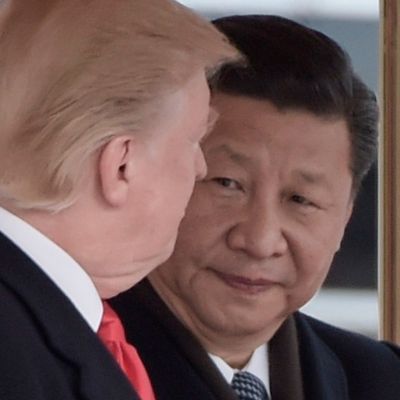
China, as promised, officially announced new retaliatory tariffs on U.S. goods on Saturday, claiming that the Trump administration had “launched a trade war” with Friday’s imposition of 25 percent tariffs on some $50 billion worth of Chinese exports. China’s Commerce Ministry released a statement early Saturday morning insisting the country did not want a trade war, but would nonetheless “fight back vigorously” now that the U.S. is starting one. “We will immediately launch tariff measures that will match the scale and intensity of those launched by the United States,” the ministry said, announcing its own 25 percent tariffs on $50 billion worth of U.S. exports.
China says its tariffs will follow the same time line as the new U.S. ones, with the first wave hitting July 6, targeting 545 U.S. products worth about $34 billion, including soybeans, whiskey, orange juice, electric cars, salmon, and cigars. The second wave of Chinese tariffs will come later in the year, aiming at 114 other products worth $16 billion, including chemicals, medical equipment, and energy products like coal, crude oil, and gasoline.
China also said that “all economic and trade agreements reached by previous negotiations will be nullified” when the new tariffs go into effect. In one of those agreements, which was conditional on Trump not threatening new tariffs, China promised to buy $70 billion worth of U.S. agricultural and energy products — a trade-deficit reducing deal which Trump had prematurely hailed as a victory.
Trump’s announcement of the tariffs on Friday followed weeks of tense and ultimately unsuccessful negotiations toward a new trade agreement between the two countries. The new U.S. tariffs, which target nearly 1,100 Chinese products (mostly advanced industrial items), are meant to punish China for stealing U.S. intellectual property and other unfair trade practices. Additional investment restrictions and export controls against China are also planned for later this month. And considering how important trade deficits are to the president, there is always a chance that he could suddenly demand more reductions in that deficit as a part of any deal.
President Trump has also said that if China retaliated — which it now has — he would target another $100 billion of Chinese exports. If Trump does that, and China again retaliates in kind, that could mean that almost all U.S. goods exported to China would face new tariffs in the near future. A full-on trade war between the U.S. and China would likely do significant economic damage to exporters in both countries, raise prices for U.S. consumers, and have widespread effects on the world economy, especially on other countries in Asia that are part of China’s manufacturing supply chain.
All of this follows Trump’s earlier trade warring against the world — including some of America’s closest allies — over steel and aluminum tariffs.
The Trump administration’s strategy is supposedly designed to force China to negotiate a more favorable agreement for the U.S., but trade experts tell Bloomberg and the New York Times that they don’t know how either side will be able to deescalate the conflict at this point, particularly since there may not be enough time between now and July 6 to work out a new agreement that is satisfactory to both sides, particularly now that trade hardliners appear to be running policy at the White House. Even if an agreement could be reached and there was enough time for China to implement it, there is never any guarantee that the notoriously uninformed and capricious Trump will understand or respect any comprehensive strategy or international agreement for any length of time in the first place.






























